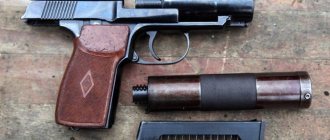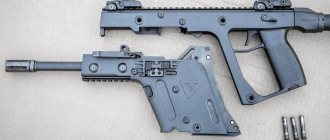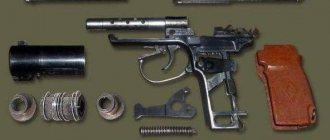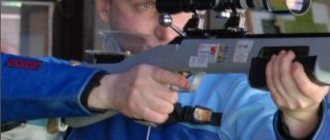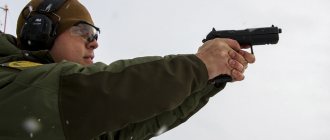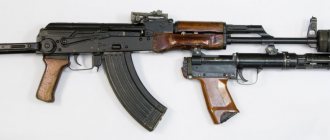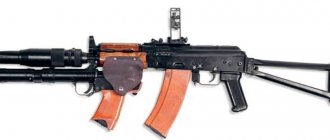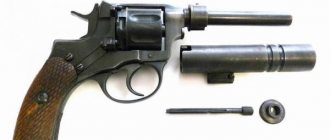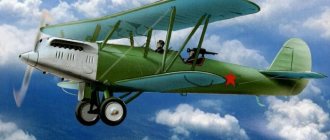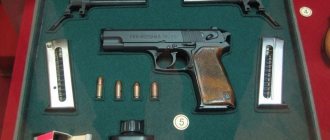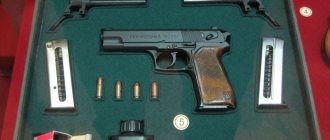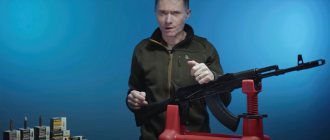Each military operation requires certain characteristics from personal small arms. For example, in an open attack, the main parameters are power, rate of fire and lethal force. If a hidden action is intended, the weapon should create as little noise as possible.
Especially for such purposes, Soviet and then Russian designers created low-noise modifications, in particular silent pistols. And one of the brightest representatives of this type of weapon is the PB (GRAU 6P9).
History of the creation of PB
The rethinking of tactical combat schemes after the Great Patriotic War led to the realization of the need to develop and introduce more advanced low-noise weapons than those already available.
This was especially important for reconnaissance and sabotage units. The ability to interfere with the enemy and determine the direction of the shot is also in demand when setting up ambushes or during combat at night.
The first sign was the creation in 1954 of the PBS silencer (the full name of the PBS is a device for silent, flameless shooting).
This device was developed and produced for the 7.62*39mm cartridge caliber, that is, for machine guns, carbines and machine guns.
For its effective use, special ammunition with the US index was used. They had a reduced initial speed, or rather subsonic. At the end of the 60s, for various reasons, it was decided to abandon the use of PBBS on light machine guns (RPD) and carbines (SKS).
However, under certain conditions, the use of these small arms was inappropriate - they were too bulky and noticeable. In these cases, the ideal option would be a pistol with reduced noise generation.
Work on the creation of such weapons was started by A.A. Deryagin, a talented Soviet designer, in the early 60s at the Central Research Institute Tochmash. He used the then popular PM (Makarov pistol) as a basis.
However, it is impossible to say that one is a modification of the other - the design of the weapon has undergone more than serious reworking. In fact, all that remained from the original PM was the trigger mechanism (also subject to modifications) and the magazine.
A prototype was provided by Deryagin in 1967. In the same year, it passed successful field and bench tests, after which it was put into service under the designation 6P9 or 6PB-9.
Shhhhhhh!
The use of a silencer (also known as silencer, suppressor, sound moderator, device for reducing the sound level of a shot, a device for silent flameless shooting, “filter”, “silence”, “moderator”, “can”, etc.) is part of the shooting culture, o the supposed complete absence of which we are so often told by opponents of weapons.
Various requirements
For athletes and amateur shooters, a silencer will help protect their own hearing and less disturb the population living near the shooting range; hunters will not disturb animals in their habitat. The military will appreciate the opportunity to hide the muzzle flash from the enemy and “smear” the sound, making it difficult to detect “by ear”. Special forces working indoors will be able to hear what is happening in the building and coordinate their activities using voice and radio communications.
An ideal silencer does not change or impair the dimensions and weight of the weapon, its balance, or accuracy. It does not require maintenance and has an almost endless resource (both in a shooting session and in general). Completely eliminates the sound of a shot, knock-up, recoil, muzzle flash, does not affect the balance of the gas system - and at the same time it is free.
Alas, the ideal muffler does not exist, and any model is an attempt by the manufacturer to find a balance between mutually exclusive requirements that will be of interest to the consumer.
All shooters have different requirements: one needs the most effective suppressor for one or two leisurely shots, but dimensions do not matter; to another - compact, but for long burst shooting. The third shoots offhand. The fourth, for indoor use, requires a silencer that does not increase the length of the weapon too much. For a fifth user, perhaps it is only important to remove the muzzle flash, and muting the sound is just a nice bonus. Therefore, there are many different models of mufflers in the world, which are quite difficult to compare. But we can deduce the definition of an ideally bad product: it is huge, heavy, infinitely expensive and makes the shot louder and the flash brighter.
Noise: we hear and measure
The noise of a shot consists of the pop of powder gases and the sounds made by the bullet and the impact of parts of the weapon. With the help of a muffler we can influence the noise made by the powder gases escaping from the barrel.
A special measuring scale is used to describe the strength of sound in the range perceived by the ear. The sound pressure level on this scale is expressed in decibels (dB). The decibel is a dimensionless unit based on the decimal logarithm. Unlike absolute units of measurement such as kilograms, meters and liters, the decibel is a relative unit and expresses the ratio of one quantity to another of the same type. We are interested in comparing sound pressure levels; an increase in level by 10 dB means that the sound pressure has increased 10 times, by 20 dB - by 10x10, that is, 100 times, by 30 dB - respectively, by 1000 times.
The use of the decibel scale when indicating sound volume is based on comparing the intensity of a sound vibration of an arbitrary spectral composition with the intensity of a harmonic sound vibration having a sound pressure amplitude equal to 20 μPa and approximately corresponding to the threshold of audibility of sound.
Sound pressure level measurement is carried out by a pulse meter, which shows the peak sound pressure level, and a frequency spectrum analyzer, which shows the distribution of the intensity of various frequencies over time. In addition, the sound pressure level depends on the location of the measurement point relative to the barrel of the test weapon.
Muffler: inside and out
Let's look at the various characteristics of the muffler.
This is what the sound of a shot with a silencer looks like on a frequency spectrum analyzer
1. STP offset and impact on accuracy
Any weight on the barrel affects its vibration when fired. Therefore, the displacement of the MTP (midpoint of impact) in this case is inevitable - this is an axiom. The magnitude and direction of this displacement are individual for each rifle complex. When installing a muffler, the accuracy may change in one direction or another. Moreover: a muffler that increases accuracy on one rifle can reduce it on another.
Silencers that have a seal in their device (a rubber washer through which a bullet passes; serves to increase the time the gases are exposed to the automation) usually have an extremely negative effect on the accuracy of the shooting system.
2. Bullet speed and sound speed
Typically, a suppressor does not affect the speed of a bullet - or, contrary to popular belief, it can slightly increase it. A shutter-type device (for example, PBS-1) actually reduces the speed of the bullet by expending its energy to overcome the shutter.
A bullet traveling faster than the speed of sound creates a fairly loud shock wave itself. For example, bullets of “thirty” caliber cartridges, depending on the speed and shape, create a sound in flight with a volume of 80-90 dB. Therefore, it is possible to achieve sound suppression “like in a movie” only by using a bullet that has a speed less than the speed of sound. It is desirable that the bullet speed in this case be 0.7-0.8 Mach (Mach number is the speed of sound propagation in air, which depends on temperature, humidity and pressure; under normal conditions it is rounded up to 330 m/s).
3. Dimensions: length, diameter, muffler volume
There is an opinion that the volume of the muffler is calculated based on the volume of powder gases, of which each gram of gunpowder supposedly forms about a liter. Actually this is not true. The gas-forming ability of most gunpowders is in the range of 500-800 cm³/g. But the gases do work by pushing the bullet - and at the same time they lose energy, cool and reduce their pressure and volume. Therefore, the actual volume of the muffler is usually determined based on the acceptability of its dimensions.
4. Form factor and interaction with sights
A silencer is still a foreign device on a weapon. Therefore, they try to make it as less disturbing as possible and more compact: they reduce the protrusion beyond the muzzle, place part of the muffler (usually part of the pre-expansion chamber, PEC) before the muzzle of the barrel, closer to the breech, and also try to ensure that the muffler does not overlap the aiming line . Naturally, these measures increase the cost of the product and/or reduce its effectiveness. For example, a silencer with a diameter of 50 mm makes it impossible to use an under-barrel grenade launcher on a Kalashnikov assault rifle; most pistols with suppressors will not fit in a standard holster, etc.
The exception is systems that initially contain an integrated muffler in their device. For example, Heckler&Koch MP5 submachine guns of SD versions or the Soviet VSS rifle have holes in the barrel through which gases flow into a silencer located around the barrel.
5. Materials, resource
The combustion products of gunpowder and primer composition settle inside the muffler. Often, especially when interacting with atmospheric moisture, they form rather aggressive compounds that destroy the metal. A stream of hot gases, entering the body of the device, has a temperature effect. In addition, the pressure of the powder gases acts on the muffler, tending to rip it off the barrel and destroy the body and partitions.
Distribution of sound pressure levels - shot without a silencer
The most durable and long-lasting products are usually stainless steel. The higher the chromium content in it, the more corrosion- and heat-resistant it is. The addition of nickel to the steel composition also ensures dimensional stability of the product when heated. But processing such steel is difficult, and any steel has a relatively high density - therefore, the muffler is usually not very light.
Titanium mufflers are slightly inferior in strength to steel ones, but they are significantly lighter. This material is also not easy to process, but has good chemical resistance. Partly due to the complexity of processing and the cost of the material, partly due to tradition, such mufflers have a fairly high price.
During intense shooting, the muffler can become almost red hot.
Aluminum-based alloys are cast, stamped, and processed by cutting. Products made from them are light, but less durable than steel. The resistance of different grades of aluminum alloys to the effects of shot products varies widely - however, as a rule, it is not too high. As a result, the service life of such suppressors ranges from just a few hundred to approximately a thousand shots.
Silencers with plastic elements typically use high-tech polymers such as Kevlar and carbon fiber. The products are very light, and usually only the body is made of plastic. Such mufflers are critical to heating and overpressure, and are also expensive.
Carbon (“rusting”) steel is not the worst material. With proper and proper maintenance, the silencer from it will withstand up to several thousand shots.
6. Muzzle flash
Almost all models of suppressors significantly reduce or completely eliminate muzzle flash. This occurs due to the fact that the hot powder gases, which under normal conditions burn out outside the barrel, cool down in the muffler and lose their energy.
Low-quality gunpowder, in addition to muzzle flash, also creates numerous sparks. Grains of gunpowder, the burning rate of which is less than that of the main charge (either they were much larger than the others, or ignited later), fly out of the barrel and continue to burn. The muffler is capable of delaying some of them, but is not able to completely overcome them. Russian-made 7.62x39 caliber cartridges are especially prone to this.
7. Impact on the balance of the gas system
The muffler body acts as a pneumatic accumulator, to some extent accumulating and maintaining gas pressure. For rifles with manual reloading this makes no difference, but weapons with a gas outlet begin to work differently. The muzzle pressure increases (not to be confused with the pressure in the chamber), and the duration and force of exposure of the gases to the gas piston or its equivalent increases. In some cases, these effects are desirable, since this is the only way to ensure reliable operation of the weapon’s automation. Typically, this applies to semi-automatic weapons with a relatively short barrel, the gas outlet of which is located far from the chamber.
If an increase in the time and force of exposure to gases is undesirable, a gas regulator is installed - a kind of valve that, at the shooter’s request, partially blocks the flow of gases. In extremely rare cases, the cartridge may need to be replaced.
8. Optimal shape of partitions and internal structure
The best results in reducing sound levels were shown by coaxial systems with asymmetric partitions. They are followed by asymmetrical partitions, similar in cross section to gears (used in products from Brugger & Thomet and A-TEC).
The correct operation of separators (partitions) can be checked by examining their smoke formation. If it is uniform, then the shape and arrangement of the internal elements are optimal. Even the same suppressor works differently on different cartridges; Some devices are better suited to swirling large volumes of gases, while others are better suited to swirling small volumes.
9. Gas discharge
Sometimes holes are made in the muffler housing to allow gases to escape. Typically their diameter is less than a millimeter. Large holes are covered with several layers of brass or stainless steel mesh to simulate small diameter holes, braking, cooling and turbulence of gases.
With a successful selection of the location and cross-section of the holes, the pressure in the muffler decreases, it returns less gases to the receiver and serves as a muzzle brake and compensator. But the mesh can become clogged with combustion products of gunpowder (especially if the gunpowder is of poor quality).
10. Overheating
Some models of mufflers are sensitive to overheating - they lose strength, may become deformed, and the level of sound reduction decreases. For example, the A-TEC carbon series of mufflers has a special temperature measurement system, similar in principle to that used in Tefal frying pans - a special mark changes color when heated.
In particularly harsh operating conditions (long burst fire), the muffler can become red-hot. Not all products can withstand this. As a rule, steel products are the most resistant to overheating.
Thermal insulating cover
11. Thermal insulation
Purely military development. The widespread use of thermal imagers has led to the development of measures to protect against detection by them. A simple way is to cover the muffler made of heat-resistant fabric (for example, Nomex) or basalt fiber to provide thermal insulation. In this case, the device cools much worse, but is less noticeable to thermal imagers. As far as I know, there have been attempts to create complexes cooled by water or carbon dioxide - but I don’t know whether they were successful. Surely such a development will be immediately classified.
12. Installation/installation nuances, supporting surfaces
The smaller the gap between the bullet and the muffler partition (that is, the smaller the diameter of the axial hole of the partition), the better the device works. However, the more difficult it is to install: the slightest deviation and the bullet will hit the partition. Therefore, a silencer for high-quality weapons usually has a gap between the bullet and the separator of about 0.5-0.7 mm. In other words: if the bullet diameter is 9.02 mm, then the diameter of the axial hole is 10-10.5 mm. Systems made less accurately and uniformly (in other words, of poor quality - such as the AKM) require the installation of a silencer in a workshop, with labor-intensive adjustment and testing - and otherwise they can upset the owner when a bullet meets a silencer. Very often, manufacturers, in order to avoid claims, radically increase the diameter of the channel - with a gap of up to 2 mm on each side. Naturally, noise reduction suffers from this, but installation and operation of the device by an unqualified user becomes possible.
Mechanism for compensating for the short stroke of the barrel, also known as a “Nielsen device”, also known as a “booster”
In order to be placed securely and motionlessly on the weapon, the silencer must be in close contact with the supporting surface - end or conical. Threads and various nuts cannot serve as a supporting surface.
Having installed the muffler, you should look into the bore from the breech side - the partitions should be invisible or visible evenly from all sides. It would also be useful to try to drop some kind of rod (for example, a cleaning rod) through the inclined barrel, the diameter of which is close to the diameter of the barrel bore. In no position should such a rod touch the muffler partitions.
Pioneer
The authorship of the first silencers is controversial, various sources give different information on this issue - but they all agree on one thing: the first manufacturer of silencers was Hiram Percy Maxim (son of Hiram Stevens Maxim, inventor of the famous machine gun). H.P. Maxim began production of silencers in 1902. Weapon silencers developed simultaneously with automobile silencers, and similar equipment is still used to study their operation.
After the first shots, you need to tighten the muffler additionally - vibrations and shocks smooth out micro-irregularities in the threads, and the tightening force weakens. It is advisable to repeat the process several times as it heats up. In the future, micro-irregularities in the thread will be smoothed out, but you still need to check the tightening force of the thread after warming up. Various fasteners more or less successfully prevent spontaneous unscrewing of the muffler, but make the process of installing the muffler more troublesome and not always uniform.
A few words about threadless fasteners:
- collet devices are suitable for low-power calibers. The more powerful the cartridge, the greater the force required for the collet to grip the barrel. It is even possible to have a local reduction in the diameter of the bore - the so-called “interception”;
- Minimum clearance fit with set screws secures only on non-spring air rifles and .22 LR firearms;
- the cam-separator mount has good reviews, but is not widely used and is quite expensive;
- the interference fit with fixation by a transverse pin (the front sight block of the AKM and early issues of the AK-74 is secured in a similar way) is reliable, but the muffler becomes non-removable.
13. Pistol silencers
In systems with a moving barrel, which are the vast majority of modern pistols, a special device is used to ensure the operation of the automation - a booster, or Nielsen device. In fact, this is a spring bushing that allows the barrel to move back at the moment when the muffler screwed onto the barrel remains in place or moves forward. A pistol on which a silencer is installed, without this device, usually becomes non-self-loading and experiences increased loads. But even a device with a booster is not universal: each pistol model requires a muffler with a certain stroke length and spring stiffness, as well as a mass that does not exceed the critical value for a given model.
14. Little tricks
A muffler soaked inside with water works much more efficiently. You can also use shaving foam instead of water.
Before installing the muffler, it is advisable to lightly lubricate the barrel thread with heat-resistant grease - it will be easier to unscrew after use.
If the silencer obscures the aiming line, aim with both eyes using open sights. After a little training, the brain will complete the picture.
No hit in the expected location - check to see if the muffler has moved. Perhaps the bullet hits the partition.
It is useful to clean the muffler periodically
15. Cleaning
Traces of smoke and soot are a kind of coating, albeit undesirable. By fighting them and trying to clean them off, we also put stress on the main coating of the muffler, if there is one - be it paint, oxide film or something else. If the original muffler coating is less resistant than carbon deposits, it will be removed during cleaning.
When shooting with “clean” powders, which cause negligible smoke formation, cleaning the muffler is not necessary. Frequent disassembly of the muffler, even if possible, is undesirable. Assembly may require a mandrel, a torque wrench, and alignment of marks. Otherwise, a more or less significant displacement of the STP may occur.
Many modern mufflers are non-separable. They are cleaned as follows:
- soaking in a cleaning solution (this can be a solvent, hot water with detergent, etc.) for a while to soften and dissolve carbon deposits;
- placement in an ultrasonic bath;
- washing cavities with a jet of cleaning solution under pressure;
- blowing cavities with compressed air.
During the cleaning process, or at least before and after, it is highly desirable to inspect the condition of the muffler using an endoscope.
The article reflects the personal experience and views of the author, is based on materials published in foreign and domestic publications, as well as on the Internet, and does not claim to be absolutely true. All pictures and quotes belong to their respected authors and are taken from open sources.
World of hobbies: Hunting & Weapons
Design
Taking the PM as a basis, Deryagin subjected all its parts to a deep modernization, so the PB cannot be called a modification of this pistol - it is a completely independent system.
Since part of the barrel is a built-in silencer, the bolt-casing of the weapon had to be seriously shortened.
This entailed a change in the position of the return spring, which is now located in the handle, and in the vertical plane
Its operation and connection with the shutter itself is carried out through a special lever element, the design of which is “seen” from the Parabellum.
The 6P9 has a two-section muffler. Its first part is a component of the barrel and is an expansion chamber equipped with a special metal mesh. Its task is to quickly cool the gases formed during the combustion of gunpowder as a result of a shot.
Their entry into the chamber is ensured by special holes in the rifling fields, which is designed to ensure optimal removal of powder gases at the moment the shot is fired.
The edge of the built-in muffler has a special thread for attaching the nozzle. The nozzle is a removable muffler, inside of which there is a separator of a special design. The latter consists of a set of washers installed inside at different angles relative to the barrel.
They split the gas flow into several small ones and give them a “swirl”.
The additional weight of the barrel acquired by the attachment does not interfere with shooting at all - it creates a greater margin of stability due to reduced barrel toss.
All this contributes to a significant reduction in noise when fired. The second component of the volume reduction was the reduction in bullet speed to the subsonic threshold - in the PM it is 290 m/s. With this indicator, the bullet does not have the ability to create a serious shock wave, which, naturally, is reflected in the sound of the shot.
Thanks to all these design features, sound suppression when firing is considered quite effective. However, it cannot be called completely silent.
The movement of contacting metal parts creates a characteristic sound that can be heard at a distance of up to 50 meters in a quiet environment. This feature of the PB must be taken into account when using it at night, especially in open areas.
For firing from 6P9, special 9-millimeter ammunition is used, which has received the US index. The initial speed of such bullets is below the speed of sound. The magazine capacity is 8 rounds.
Advantages and disadvantages
This device has very few disadvantages:
- price;
- difficulty of design;
- difficulty in obtaining permission to purchase (confirmation of use by type of activity is required.
- But there are many more advantages that can be identified:
- weapon balancing;
- high maneuverability;
- ergonomics;
- significant reduction in shot noise;
- muzzle brake compensator function
- increased strength;
- Style (a weapon equipped with a suppressor looks more powerful).
Specifications
The performance characteristics of the PB silent pistol (GRAU 6P9/6PB-9) are contained in the following table:
| Magazine capacity | 8 rounds |
| Number of cartridges in full equipment | 9 (1 cartridge per barrel) |
| Type of ammunition used | 9*18mm (PM-US) |
| Sighting range | up to 25m / up to 50m |
| Rate of fire | 30 min. |
| Initial bullet speed | 290m/s |
| Weight | 950g (without cartridges), 1120g (loaded) |
| Length | 310mm (with muffler), 170mm (without muffler) |
| Height and width | 134*32mm |
| Barrel length | 100mm |
Silencer for various weapons
Every man is interested in how a pistol silencer works. The speed of a bullet leaving such a weapon is approximately 300 meters per second, which means that it does not exceed the speed of sound. It also has less energy, which means noise reduction is easier. But the big disadvantage is the reduction in the already low penetration ability. Most modern pistols are designed so that the entire bolt covers the barrel. To fit the suppressor, it was necessary to change the structure of the bolt and cut a special protrusion on the barrel. A standard example of such a pistol is the Chinese Type-64, in which the suppressor is integrated with the barrel, and the cells are located under and around it. Each compartment contains a mesh to absorb heat.
Reducing the noise of a firing revolver is much more difficult, since gases escape between the drum and the muzzle of the barrel. In the case of submachine guns, it’s a little easier. The forend and the damper are one piece. Suppressors for shotguns were developed specifically for bodyguards.
Areas of use
The main customers of the PB silent pistol were reconnaissance and reconnaissance and sabotage units of the troops. For example, among GRU (Main Intelligence Directorate) special forces fighters, the presence of 6P9 in their equipment has become mandatory.
The KGB became another regular customer of weapons, especially after the appearance in their ranks of such special units as “Alpha” and “Vympel”. In addition, different departments can order silent pistols for specialized purposes.
For example, the Belarusian Ministry of Internal Affairs purchases the model in question for the execution of death sentences.
Production of the 6P9 was discontinued in 1987 in favor of new types of silent pistols. However, in 2003, the Izhevsk Mechanical Plant resumed production of PB.
Many experts recognized that ease of maintenance and use, as well as the use of common ammunition, more than compensated for all the shortcomings of the pistol. The scope of application after this, of course, did not change.
The principle of operation of the muffler
At a certain distance from the muzzle there is a wide rubberized membrane. Gases move between the cartridge and the walls of the barrel and are stopped by a membrane, from where they enter the compartments, and only after that they are released into the atmosphere with a significantly reduced pressure and temperature. Such a tool can last up to 200 volleys without replacing the washer. The shape of the washer can be either straight or curved. In the latter case, the powder waste is deflected towards the edge of the damper and does not advance ahead of the cartridge. The same effect is obtained when using a helical partition.
The suppressor is a fairly voluminous element that changes the balancing of the weapon and complicates the aiming process. This can be avoided through a peculiar arrangement.
Other models of silent pistols
In addition to the PB, the domestic arms industry has created several more models positioned as silent or silenced pistols. One of the first was the C4, developed back in the 60s.
The pistol had two barrels located in a vertical plane and used ammunition of 7.62*63mm PZ caliber, and later 7.62*63mm PZAM. On their basis, the SME was developed - the Small-sized special pistol "Groza", also designated 6P24 and TOZ-37.
This model was adopted into service in 1972. The design of the pistol implied the use of a closed-type cartridge SP-3. It was withdrawn from service due to the development of more advanced ammunition of this type and weapons for it.
Speaking about silent weapons, one cannot fail to mention the APB (Automatic Silent Pistol), developed on the basis of the famous APS.
Its quiet operation was achieved through the use of a specially created removable muffler and an expansion chamber under the casing.
It was possible to use it in automatic firing mode, just like the APS. He was especially popular among special forces soldiers. Ceased to be produced due to the high cost of production and maintenance, but is still actively used by special forces soldiers.
All of these models have certain disadvantages. They were taken into account when designing the PSS (Special Self-Loading Pistol), developed in the late 70s and early 80s. This model was one of the last to be adopted - in 1983.
A new type of ammunition with gases locked inside the SP-4 cartridge case was developed especially for it. Now it is gradually being replaced by a modified version of the PSS-2, which has even more impressive characteristics. However, in several respects it still loses to PB - ease of maintenance and manufacturing cost.
Among the developments of domestic designers there is also a silent revolver - OTs38 (special Stechkin revolver).
It uses special 7.62mm ammunition with internal gas locking, which ensures a silent shot.
Muffler device
The standard version of the device has a classic look. This is a muzzle mechanism that is applied to various variations of firearms. It is fixed on the barrel or is a continuation of the design provided by the manufacturer. The main task of the device is to reduce the sound level and reduce the volume of fire from the combustion of gunpowder, to ensure the shooter's secrecy.
This feature is very important for military operations, because there is no particular need for a hunter in the forest or a shooter in the field to hide. And for a military man, it is very important not so much to reduce the noise of shooting as to hide sparks and flashes in the dark. With the help of flashes of light, the shooter is very easy to detect and will become an excellent target for the enemy. The suppressor also has a number of useful advantages, such as shooting intensity. There is also minimal gun recoil.
The suppressor looks like a cylinder made of metal materials: steel, copper, aluminum, a durable plastic mass can be used. Inside it there are cells in which the powder gas is removed. Most often, the device is attached to the end of the barrel using a special thread.
At the instant of the shot, gases penetrate the compartments and lose speed in them.
The chambers can also be filled with materials that absorb heat: aluminum mesh or shavings, copper wire. In this case, the gases cool themselves when the filler is heated and reduce their pressure. But such fillers are difficult to clean and are simply replaced. The noise level can also be affected by the material from which the partitions are made. If you replace steel parts with aluminum ones, the sound of shooting will be significantly lower. But such designs also have disadvantages. During a long series of shots, the pressure in the compartments increases, the cooling parts heat up and the productivity of the mechanism decreases. Subsequently, the main task and benefit of the device will be lost. Designers advise firing one salvo at a time with a large period of time between them so that the structure has time to cool down.
Sig-Sauer P226
In second position among the 10 best pistols in the world is a joint development of Germany and Switzerland. It was put into operation in 1983, but even today the weapon is still modern and does not lose in quality and power. If we consider the Sauer pistol from the technical side, then this is a very cool option, it is almost perfect, there are no flaws to be found. Of course, two countries with the most precise engineers worked on them. The weapon has an automatic safety. In general, for the military or law enforcement agencies, the Sauer pistol can be an excellent option.
- Year of issue: 1981
- Weight: 802 grams
- Barrel length: 11.2 cm.
- Caliber: 9 mm.
- Bullet speed: 370 m/s
- Magazine: 12 rounds
- Country: Switzerland-Germany
Top most powerful airsoft pistols
We took from the assortment of the Airsoft Planets store a selection of models that are most popular among customers and shot them on a chronograph. Read about the results below.
*Important
. Measurements of the initial firing velocity of pistols were measured at the time of writing. In other time periods: in the past, future, or even in the present, but in other games, the results may differ.
shooting a pistol on a chronograph
Spring pistols
The most inexpensive and simple models, in which the spring must be cocked manually before each shot. A weapon of last resort, but better than a knife or nothing. It should be noted that with similar dimensions, the initial velocity of the shot is almost identical for all: 60 m/s plus/minus. You can shoot effectively at 10–15 meters.
- Galaxy PM (g29) — 50 m/ s
- Galaxy SIG226 (g26) - 52 m/s
- Galaxy Colt Hi Capa 5.1 (g6) - 56 m/s
- Smart Colt M1911 A1 (g.18.4) - 58 m/s
- Galaxy Colt M1911 A1 (g13) - 59 m/s
- Galaxy Browning (g20) — 60 m/s
- Galaxy Colt 1911 4.3 (g25) - 63 m/s
There is no clear leader among the springs, the only thing that stands out is the Galaxy Browning G20, which has a slightly higher speed due to its slightly longer barrel, but the leader suddenly became the not very long Galaxy Colt 4.3 - apparently it was a good batch.
Electric pistols
The best choice of secondary weapons in terms of price/quality/unpretentiousness. However, in terms of power, electric pistols are not far from the same Galaxy springs. There is practically no difference between the models. However, despite the low power, there is a hop-up module that spins the ball and allows you to shoot heavier ammunition: 0.25 and 0.28 gram balls. Firing range (effective) up to 20 - 25 meters.
- Cyma Beretta M92 (cm126) - 63 m/s
- Cyma USP (cm125) — 64 m/s
- Cyma P226 (cm122) — 65 m/s
- Cyma Colt M1911 (cm123) - 65 m/s
- Cyma Glock 18C (cm030) - 65 m/s
- Cyma Desert Eagle (cm121) — 70 m/s
The most powerful among electrics is the Cyma Desert Eagle
. Of course, look how healthy he is! But, of course, weight is not what determines a high score. It shows the best results due to the long barrel, which allows the ball to accelerate longer.
Well, we’re done with the weaker categories, let’s move on to the gas versions.
Airsoft pistols on greengaz
The shooting was carried out at room temperature and the gas tank was fully charged. At first, the speed of all models is higher, but after a few shots it drops, so we took the average for two fired magazines. Taking into account the presence of the hop-up module, you can effectively shoot pistols on a greengaz at 30 meters, and with good tuning and dexterity, at 40.
WE's PMA feature is an internal barrel extension that hides the muffler
- WE Glock 17 gen.3 - 95 m/s
Classic Glock, one of the most popular models. The power indicator is typical for all modifications of Glock 17 and 18 from WE of similar dimensions in various colors and generations.
- WE TT - 95 m/s
The legendary TT or TT-33 in airsoft version (and its chrome version) produces on average a stable speed that is quite adequate for a pistol.
- KJW CZ-75 — 98 m/s
Replica of a popular service pistol made in Czechoslovakia. At first it gives a result of 108 m/s, but on average around 100 m/s.
- WE Colt 1911 A1 - 100 m/s
Various modifications of WE Colts show results of 100 m/s. Due to the long barrel, you can conduct effective targeted fire.
- WE Browning Hi Power
- 100 m/s
Replica of the famous American pistol and its chrome version. Also a pretty good result, a strong middle. - KJW Beretta M9 - 105 m/s
Greengaz Berettas from KJ Works have a slightly higher average speed.
- WE Glock 34 gen.3 - 110 m/s
The Glock 34 modification is originally used for target shooting. The long barrel allows you to accelerate the ball better, which is what determines the result.
- WE PM, muffler - 115 m/s
WE's Makarov comes with an internal barrel extension and a suppressor to protect and conceal it. In the usual version, the average speed does not exceed 95 - 100 m/s, and when an extension cord is installed, it immediately increases noticeably to 115 m/s, which is a fairly high figure. There is also a chrome version.
- KJ Works Ruger MK1 - 125 m/s
And finally, the legend in terms of power among green gas pistols is the KJW Ruger MK1. Quite a powerful model without a blowback. It is also available in a modification with a long barrel and a frame stock, which turns it into a compact self-loading carbine. Maximum power - 130 m/s.
The indicators show that the average speed fluctuates around 100 m/s. The most powerful - KJW Ruger MK1
, but this is a rather rare bird. But WE PM with a muffler is much more common. Let's move on to the final part...
Glock 17
The revolutionary combat pistol comes from Austria and it became the first model in history from this company to this day. One of the most durable materials in terms of quality, stability and low weight compared to competitors. This is why it is easier to carry, especially for authorities. The Glock 17 pistol was adopted in the 1980s; at the moment, a unit can cost 599 bucks. Probably the coolest thing that characterizes the barrel is the ability to shoot even under water, provided that there is a reinforced spring there.
- Year of issue: 1980
- Weight: 625 grams
- Barrel length: 11.4 cm.
- Caliber: 9 mm
- Bullet speed: 375 m/s
- Magazine: 17 rounds
- Country: Austria
[ads-pc-2]
[ads-mob-2]
CZ-75
The rating of pistols in the world is also supplemented by a Czech copy, which appeared back in 1975, but gained enormous popularity. A year was enough to test it and send it into service with local police. There is nothing new in the operation of automation; it is a classic system that is reliable and does not fail. The weapon has a safety lever, the lever itself is located on top of the handle. Units of CZ-75 pistols are in service with the army due to their reliability and excellent performance in combat. It is also worth highlighting the high penetration ability of bullets with a caliber of 9 millimeters. Due to excellent balancing, you can perform so-called offhand shots without discomfort. Not all Russian army pistols can achieve similar results.
- Country: Czech
- Length: 20.6 cm
- Barrel: 12 cm
- Caliber: 9 mm
- Bullet speed: 250 m/s
- Sighting range: 50 m
- Magazine: up to 16 rounds
- Weight: 1120 g
HK USP
A universal weapon from the well-known German company Heckler & Koch is included in the best pistols of 2022 2021 and not just like that, but because it is really worthwhile. When designers began to create this weapon, the pistol was intended for the market in the United States. As a result, it turned out to be much more popular and spread all over the world. Over 10 options for barrel modification have already been invented.
- Year of issue: 1989
- Weight: 748 grams
- Barrel length: 10.8 cm.
- Caliber: 9 mm
- Bullet speed: 350 m/s
- Magazine: 15 rounds
- Country: Germany
Walther P99
Speaking about what are the best pistols one cannot fail to mention the Walter, created by the Germans and known for its luxurious characteristics. More modern technologies were used in the manufacture of the barrel; as a result, the handle of the Walther P99 is made of polymer materials and comes in two shades. The firing pin is removed using a button; there is no non-automatic safety lock here. Depending on the scope, the firing range can be increased to 100 meters.
- Year of issue: 1994
- Weight: 700 grams
- Barrel length: 10.2 cm.
- Caliber: 9 mm and .40
- Bullet speed: 375 m/s
- Magazine: 16 rounds
- Country: Germany
Colt M1911
One of the most recognizable of the top 10 pistols in the world today, better known as the Colt. The self-loader was developed back in 1908, and in 1911 it already entered service with officers, sergeants and some units of the US Army. Today, police officers often have one of these in their arsenal. A well-known collectible Colt 45 caliber can cost at least 1 thousand bucks; it is highly valued.
- Year of issue: 1908
- Weight: 1120 grams
- Barrel length: 12.7 cm.
- Caliber: .45 ACP
- Bullet speed: 260 m/s
- Magazine: 7 rounds
- Country: USA
Desert Eagle
If the army begins to wonder which pistol is better with a large caliber, then this is naturally the Desert Eagle, legendary in appearance and the most recognizable in the world. Self-loading type, it is even classified as a hunting weapon. Often weapons can be seen in different films or even games, all thanks to their large dimensions and shiny metal body. The barrel has a long firing range and, accordingly, accuracy. But a combat pistol is quite expensive, at least 2 thousand bucks.
- Year of issue: 1983
- Weight: 1700 grams
- Barrel length: 15.2 cm.
- Caliber: .357 Magnum.
- Bullet speed: 390 m/s
- Magazine: 9 rounds
- Country: USA and Israel
[ads-pc-1]
[ads-mob-1]
FN Five-seveN
The Belgian company not long ago released a barrel that found its way into the best pistols in the world and began to glorify the company throughout the planet. The main difference from its predecessors is the cartridges; this pistol uses a 5.7 mm caliber, as well as a bottle-shaped cartridge case. This option was invented specifically for FN Five-seveN.
- Year of issue: 1993
- Weight: 610 grams
- Barrel length: 12.2 cm.
- Caliber: 5.7 mm
- Bullet speed: 520 m/s
- Magazine: 20 rounds
- Country: Belgium
